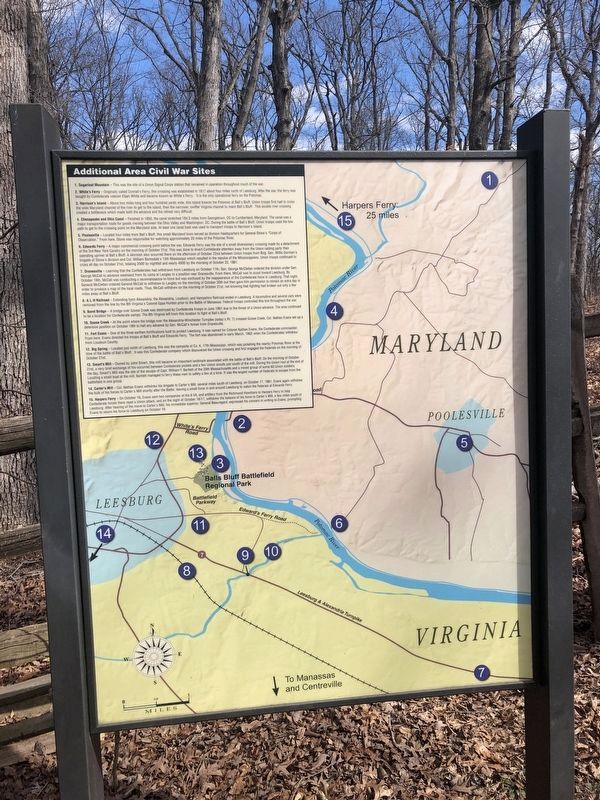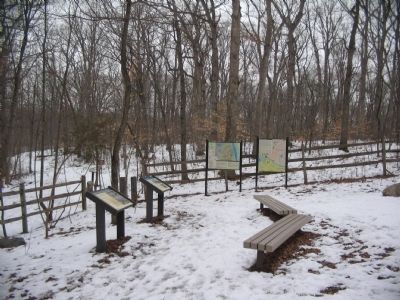Leesburg in Loudoun County, Virginia — The American South (Mid-Atlantic)
Additional Area Civil War Sites
1. Sugarloaf Mountain - This was the site of a Union Signal Corps station that remained in operation throughout much of the war.
2. White's Ferry - Originally called Conrad's Ferry, this crossing was established in 1817 about four miles north of Leesburg. After the war, the ferry was bought by Confederate veteran Elijah White and became known as White's Ferry. It is the only operational ferry on the Potomac.
3. Harrison's Island - About two miles long and four hundred yards wide, this island bisects the Potomac at Ball's Bluff. Union troops first had to cross the wide Maryland channel of the river to get to the island, then the narrower, swifter Virginia channel to reach Ball's Bluff. This double river crossing created a bottleneck which made both the advance and the retreat very difficult.
4. Chesapeake and Ohio Canal - Finished in 1850, the canal stretched 184.5 miles from Georgetown, DC to Cumberland, Maryland. The canal was a major transportation route for goods moving between the Ohio Valley and Washington, DC. During the battle of Ball's Bluff, Union troops used the tow path to get to the crossing point on the Maryland side. At least one canal boat was used to transport troops to Harrison's Island.
5. Poolesville - Located four miles from Ball's Bluff, this small Maryland town served as division headquarters for General Stone's "Corps of Observation." From here, Stone was responsible for watching approximately 20 miles of the Potomac River.
6. Edwards Ferry - A major commercial crossing point before the war, Edwards Ferry was the site of a small diversionary crossing made by a detachment of the 3rd New York Cavalry on the morning of October 21st. This was done to divert Confederate attention away from the Union raiding party then operating upriver at Ball's Bluff. A skirmish also occurred there on the afternoon of October 22nd between Union troops from Brig. Gen. Willis Gorman's brigade of Stone's division and Col. William Barksdale's 13th Mississippi which resulted in the repulse of the Mississippians. Union troops continued to cross all day on October 21st, totaling 2500 by nightfall and nearly 4500 by the morning of October 22, 1861.
7. Dranesville - Learning that the Confederates had withdrawn from Leesburg on October 17th, Gen. George McClellan ordered the division under Gen. George McCall to advance westward from its camp at Langley to a position near Dranesville. From there, McCall was to scout toward Leesburg. By October 19th, McCall was conducting a reconnaissance-in-force but was confused by the reappearance of the Confederate force in Leesburg. That night, General McClellan ordered General McCall to withdraw to Langley on the morning of October 20th but then gave him permission to remain an extra day in order to produce a map of the local roads. Thus, McCall withdrew on the morning of October 21st, not knowing that fighting had broken out only a few miles away at Ball's Bluff.
8. A.L.H. Railroad - Extending from Alexandria, the Alexandria, Loudoun, and Hampshire Railroad ended in Leesburg. A locomotive and several cars were removed from the line by the 8th Virginia's Colonel Eppa Hunton prior to the Battle of Manassas. Federal troops controlled this line throughout the war.
9. Burnt Bridge - A bridge over Goose Creek was destroyed by Confederate troops in June 1861 due to the threat of a Union advance. The area continued to be a location for Confederate camps. The 8th Virginia left from this location to fight at Ball's Bluff.
10. Goose Creek - At the point where the bridge over the Alexandria-Winchester Turnpike (today's Rt. 7) crossed Goose Creek, Col. Nathan Evans set up a defensive position on October 19th to halt any advance by Gen. McCall's forces from Dranesville.
11. Fort Evans - One of the three earthen fortifications built to protect Leesburg, it was named for Colonel Nathan Evans, the Confederate commander. From here, Evans directed his troops at Ball's Bluff and Edwards Ferry. The fort was abandoned in early March 1862 when the Confederates withdrew from Loudoun County.
12. Big Spring - Located just north of Leesburg, this was the campsite of Co. K, 17th Mississippi, which was picketing the nearby Potomac River at the time of the battle of Ball's Bluff. It was this Confederate company which discovered the Union crossing and first engaged the Federals on the morning of October 21st.
13. Smart's Mill - Owned by John Smart, this mill became an important landmark associated with the battle of Ball's Bluff. On the morning of October 21st, a very brief exchange of fire occurred between Confederate pickets and a few Union scouts just south of the mill. During the Union rout of at the end of the day, Smart's Mill was the site of the escape of Capt. William F. Bartlett of the 20th Massachusetts and a mixed group of some 80 Union soldiers. Locating a small boat at the mill, Bartlett managed to ferry these men to safety a few at a time. It was the largest number of Federals to escape from the battlefield in one group.
14. Carter's Mill - Col. Nathan Evans withdrew his brigade to Carter's Mill, several miles south of Leesburg, on October 17, 1861. Evans again withdrew the bulk of his forces to Carter's Mill shortly after the Battle, leaving a small force in and around Leesburg to watch the Federals at Edwards Ferry.
15. Harpers Ferry - On October 16, Evans sent two companies of the 8 VA, and artillery from the Richmond Howitzers to Harpers Ferry to help Confederate forces there repel a Union attack, and on the night of October 16/17, withdrew the balance of his force to Carter's Mill, a few miles south of Leesburg. After hearing of the move to Carter's Mill, his immediate superior, General Beauregard, expressed his concern in writing to Evans, prompting Evans to return his force to Leesburg on October 19.
Erected 2009.
Topics and series. This historical marker is listed in this topic list: War, US Civil. In addition, it is included in the Chesapeake and Ohio (C&O) Canal series list. A significant historical year for this entry is 1817.
Location. 39° 7.826′ N, 77° 31.842′ W. Marker is in Leesburg, Virginia, in Loudoun County. Marker is on Ballís Bluff Road, on the right when traveling east. Located inside Ballís Bluff Regional Park, just off the parking lot. Touch for map. Marker is in this post office area: Leesburg VA 20176, United States of America. Touch for directions.
Other nearby markers. At least 8 other markers are within walking distance of this marker. Battle of Balls Bluff (here, next to this marker); Aftermath of Ballís Bluff (here, next to this marker); The Battle of Ball's Bluff in Perspective (here, next to this marker); A Divided America, A Divided Loudoun County (here, next to this marker); The Battle at Ballís Bluff (within shouting distance of this marker); Battle of Ball's Bluff - October 21, 1861 (about 300 feet away, measured in a direct line); a different marker also named The Battle of Ball's Bluff (about 300 feet away); 8th Virginia Volunteer Infantry Regiment (about 400 feet away). Touch for a list and map of all markers in Leesburg.
Credits. This page was last revised on March 6, 2021. It was originally submitted on February 22, 2010, by Craig Swain of Leesburg, Virginia. This page has been viewed 1,753 times since then and 54 times this year. Photos: 1. submitted on March 6, 2021, by Devry Becker Jones of Washington, District of Columbia. 2. submitted on February 16, 2010, by Craig Swain of Leesburg, Virginia.

